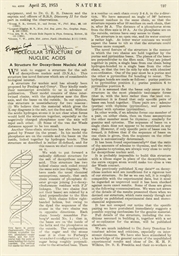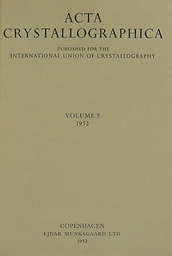CRICK, Francis H.C. (1916-2004) and WATSON, James D.(b.1928). Galley proof signed ("Francis Crick" and "James D. Watson"), "Genetical implications of the structure of deoxyribonucleic acid." Nature 171 (1953): 964-967. Two galley pages, 570 x 153mm each (first page repaired at fold, pin holes to upper margin, a little creasing). "Until now, however, no evidence has been presented to show how [DNA] might carry out the essential operation required of a genetic material, that of exact self-duplication." Watson & Crick explore the profound implications alluded to only weeks earlier . Their 25 April 1953 paper that identified the double helix structure had ended with a teaser: "It has not escaped our notice that the specific pairing we have postulated immediately suggests a possible copying mechanism for the genetic material." Their 30 May 1953 follow-up—of equal importance to the revelation of 25 April—sought to explain the chemical mechanism by which cells pass on their character accurately. "Genetical implications" begins by acknowledging that the importance of DNA within living cells is "undisputed," noting that "[m]any lines of evidence indicate that it is the carrier of a part of (if not all) the genetic specificity of the chromosomes and thus of the gene itself. Until now, however, no evidence has been presented to show how it might carry out the essential operation required of a genetic material, that of exact self-duplication." The paper continues with an explicit and concise description of the biologically important features, and despite some remaining uncertainties about the unproved nature of the structure in question, Crick and Watson conclude that "we feel that our proposed structure for deoxyribonucleic acid may help solve one of the fundamental biological problems—the molecular basis of the template needed for genetic replication." The publication of Watson & Crick's papers in the April and May issues of Nature together revolutionized biochemistry and the other life sciences, and profoundly affected the study of molecular biology. As noted in the previous lot, the present proofs are the earliest typeset version of Watson & Crick's text, and the only galleys which are extant. This proof also bears small differences from the version that appears in Nature ; there are small emendations to the references in the footnotes. There is a pencil note at the upper margin of the first page, "returned 18 May '53," i.e. 12 days before publication and probably about two weeks after the manuscript was submitted to Nature . A previous owner of this and the preceding lot suggests that they both derive from the collection of Linus Pauling (1901-1994). Pauling's lab at Caltech was the only one apart from the Cambridge and King's College labs in the U.K. to be competing in the race to determine the structure of DNA. Garrison-Morton 256.3.
CRICK, Francis H.C. (1916-2004) and WATSON, James D.(b.1928). Galley proof signed ("Francis Crick" and "James D. Watson"), "Genetical implications of the structure of deoxyribonucleic acid." Nature 171 (1953): 964-967. Two galley pages, 570 x 153mm each (first page repaired at fold, pin holes to upper margin, a little creasing). "Until now, however, no evidence has been presented to show how [DNA] might carry out the essential operation required of a genetic material, that of exact self-duplication." Watson & Crick explore the profound implications alluded to only weeks earlier . Their 25 April 1953 paper that identified the double helix structure had ended with a teaser: "It has not escaped our notice that the specific pairing we have postulated immediately suggests a possible copying mechanism for the genetic material." Their 30 May 1953 follow-up—of equal importance to the revelation of 25 April—sought to explain the chemical mechanism by which cells pass on their character accurately. "Genetical implications" begins by acknowledging that the importance of DNA within living cells is "undisputed," noting that "[m]any lines of evidence indicate that it is the carrier of a part of (if not all) the genetic specificity of the chromosomes and thus of the gene itself. Until now, however, no evidence has been presented to show how it might carry out the essential operation required of a genetic material, that of exact self-duplication." The paper continues with an explicit and concise description of the biologically important features, and despite some remaining uncertainties about the unproved nature of the structure in question, Crick and Watson conclude that "we feel that our proposed structure for deoxyribonucleic acid may help solve one of the fundamental biological problems—the molecular basis of the template needed for genetic replication." The publication of Watson & Crick's papers in the April and May issues of Nature together revolutionized biochemistry and the other life sciences, and profoundly affected the study of molecular biology. As noted in the previous lot, the present proofs are the earliest typeset version of Watson & Crick's text, and the only galleys which are extant. This proof also bears small differences from the version that appears in Nature ; there are small emendations to the references in the footnotes. There is a pencil note at the upper margin of the first page, "returned 18 May '53," i.e. 12 days before publication and probably about two weeks after the manuscript was submitted to Nature . A previous owner of this and the preceding lot suggests that they both derive from the collection of Linus Pauling (1901-1994). Pauling's lab at Caltech was the only one apart from the Cambridge and King's College labs in the U.K. to be competing in the race to determine the structure of DNA. Garrison-Morton 256.3.
.jpg)

.jpg)












Testen Sie LotSearch und seine Premium-Features 7 Tage - ohne Kosten!
Lassen Sie sich automatisch über neue Objekte in kommenden Auktionen benachrichtigen.
Suchauftrag anlegen